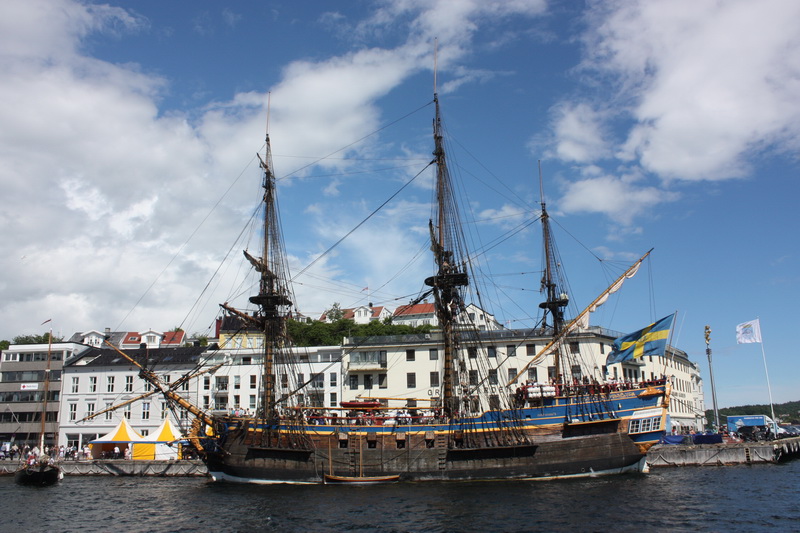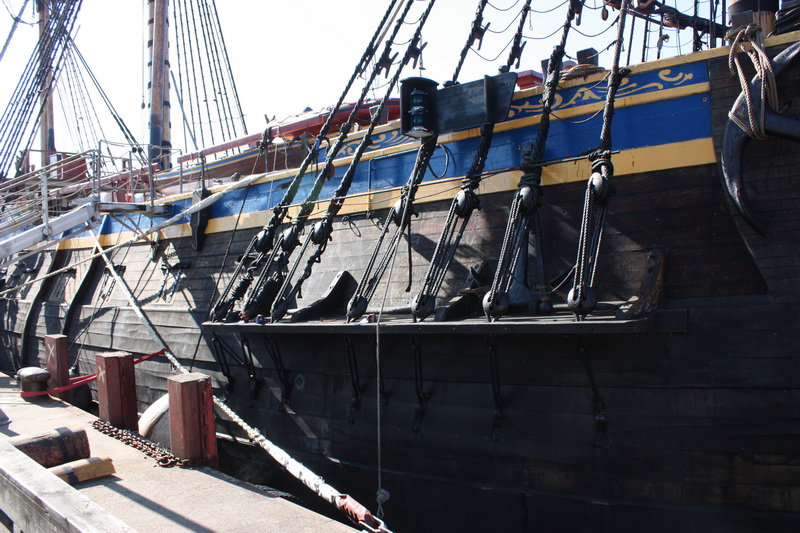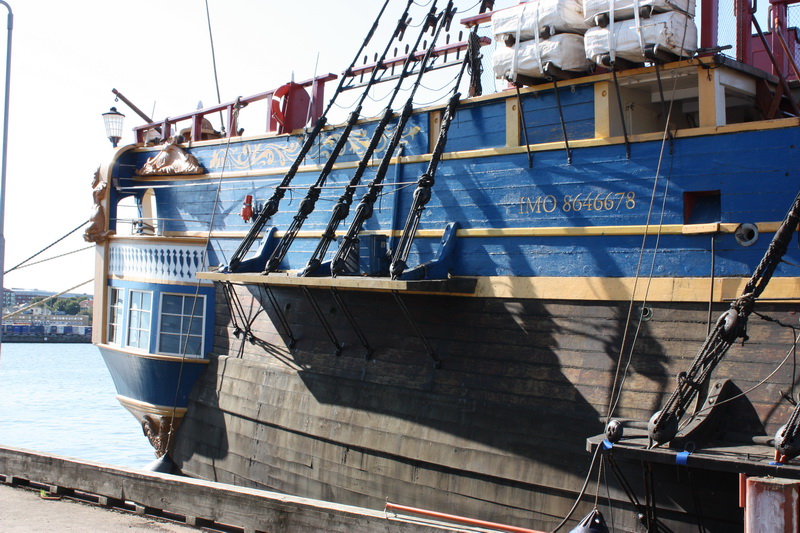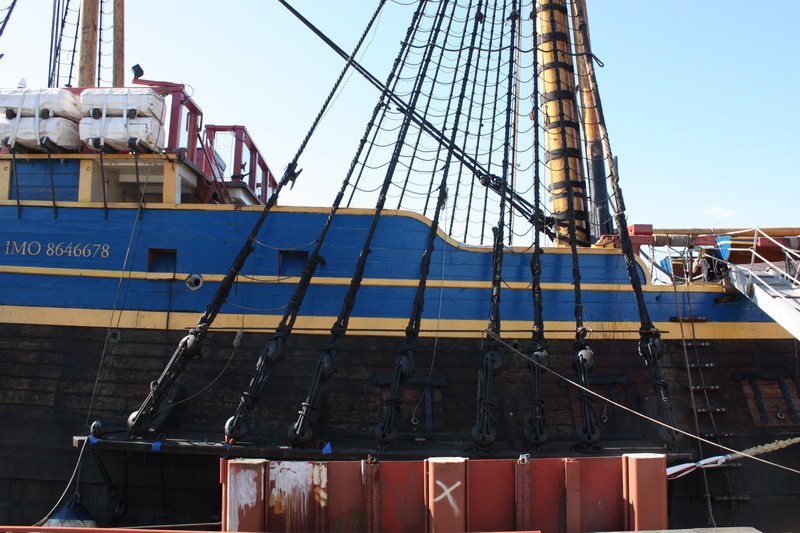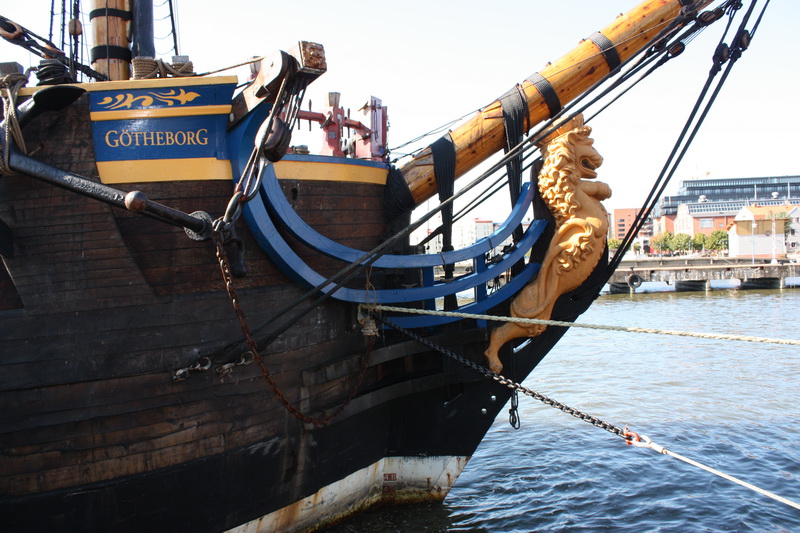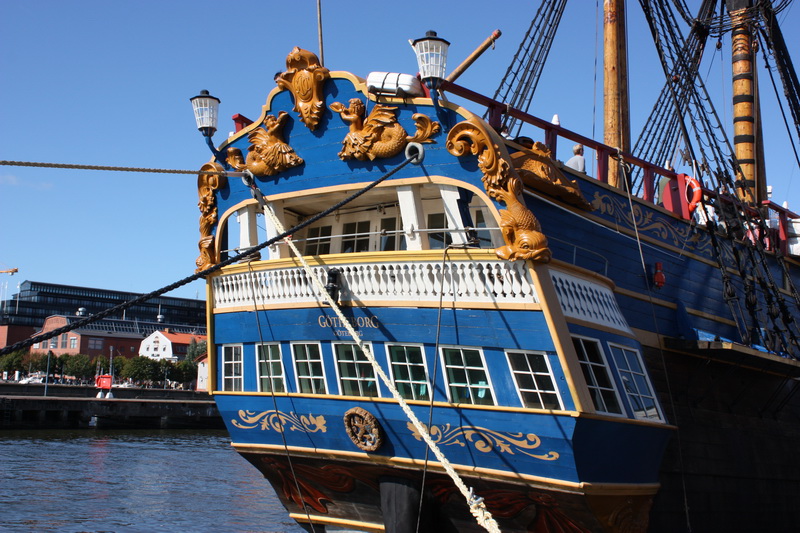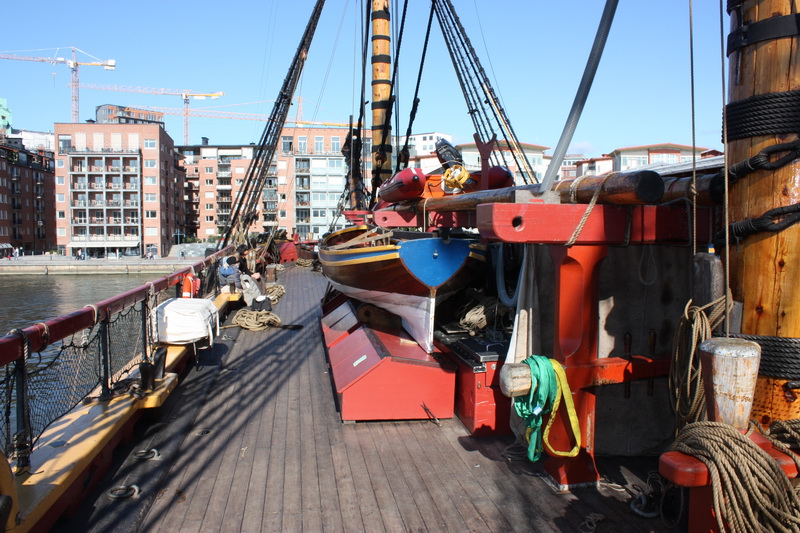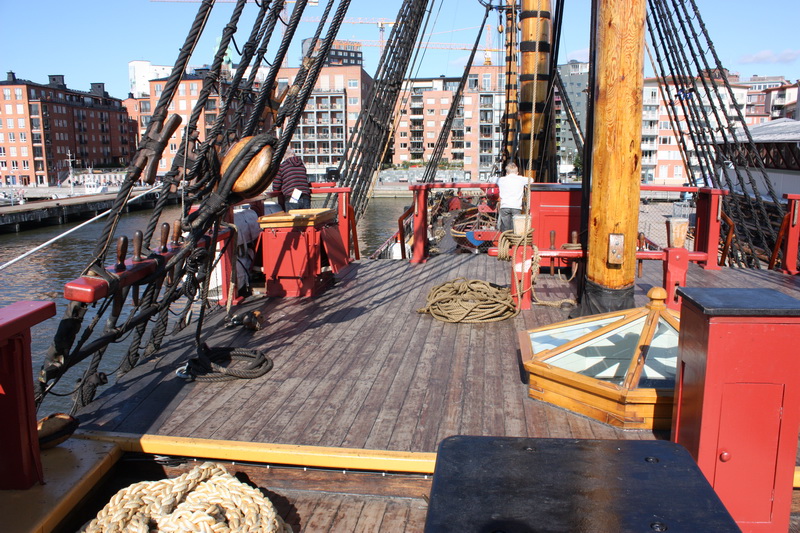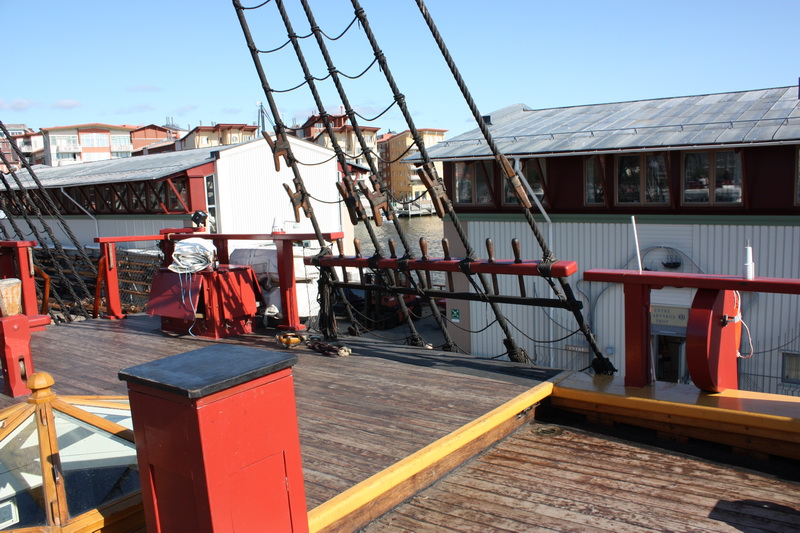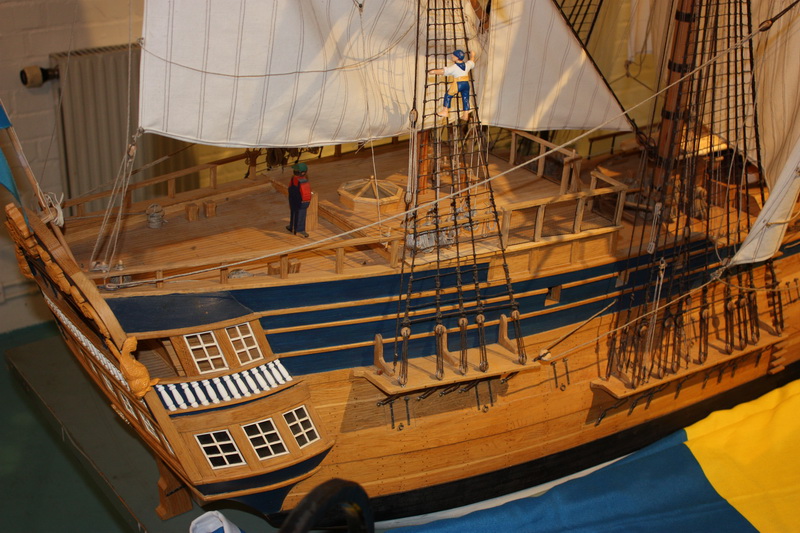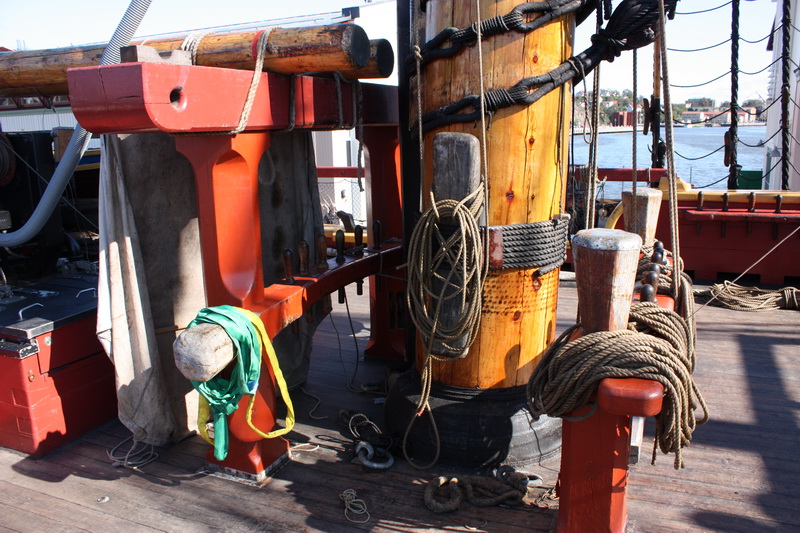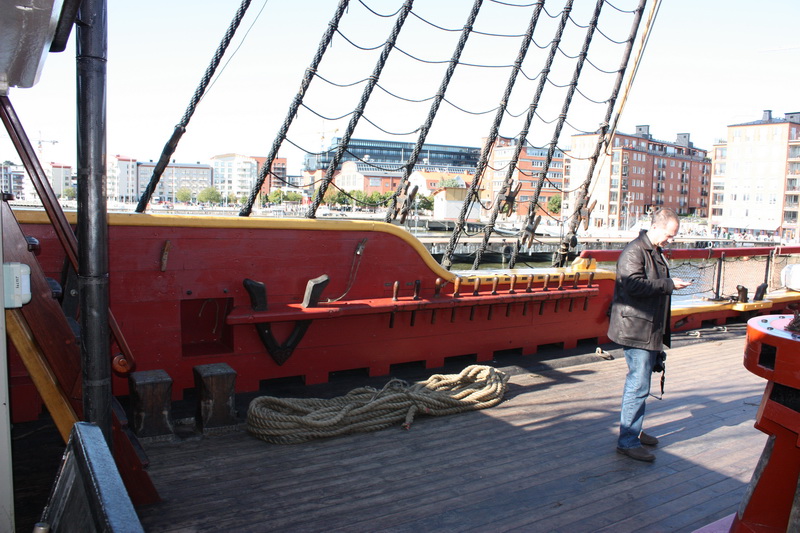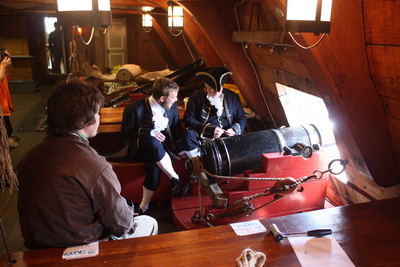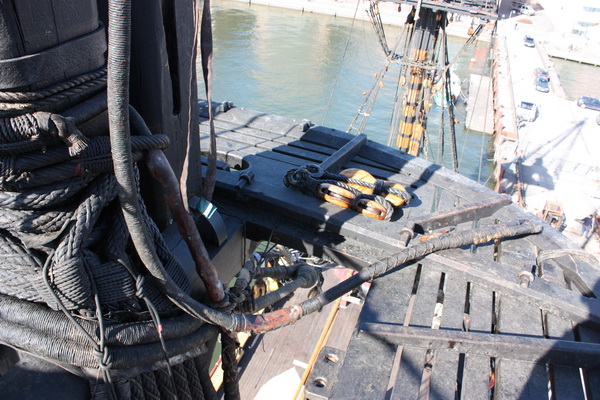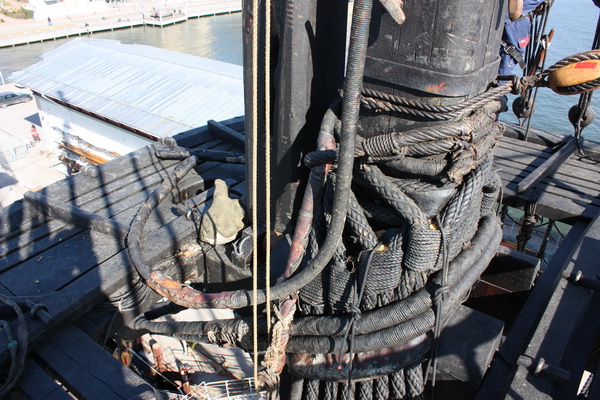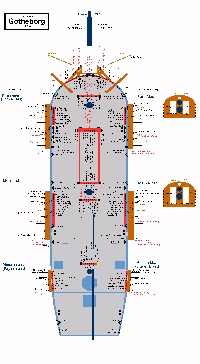Galleries
Walk Onboard - Active Sailing Ships
Sweden - The East-India-Man "Götheborg III"
|
January 2008: I emigrated from Germany to Sweden eventually, starting a new life. What I could not know then was that this would also give me a chance soon, to fulfill my dream: sailing with a three-master ... Full View
The Hull and The Sides
The color scheme of the ship is white under the water, black (tarred) on the waterline, natural wooden (but varnished) around the gundeck and the lower deck (that also had guns in the original ship), and on top of it, "Swedish" blue-yellow on the rails.
Debate: the Blue ColorIf the original ship really was BLUE (or any other ship of this area) is a matter of discussion! Why? So many paintings and the finest ship models depict the ships is the marvellous blue and gold scheme, or ocre as a cheaper gold "replacement". The point is that the contemporary artists took a lot of freedom to paint the ships in the most beautiful colors - in order to have their artworks sold to a high price for the - mostly royal - audience. "Realism" was of second priority only. But BLUE as a painting color for the ships sides is about the most UN-probable color ever! The raw materials to produce blue color were even much more expensive than gold, and there were no synthetic colors those days: "Lapis lazuli" and other extremely rare blue pigments were needed to make blue, but even the small amounts used by the artists were very expensive, not to speak for the purpose of painting a whole ships side! Only the Royal ships in the Absolutistic Eras were decorated with carvings AND painted in expensive colors and gold leafs. Any color - EXCEPT blue! So far we have historic evidence, that what appeared blue would probably been some other color, in the easiest case simply black, or green, or coming most close to blue: indigo. But that gave a very dark blue and was also very difficult to produce, hence expensive. Nobody but the king would pay so much money to have his ship painted in this color! Today we are all used to see the "classic" blue-gold scheme, because we have much cheaper color production techniques today. Blue today is a color like any other - just it is very beautiful. The entire galleon waterbreaker of the Götheborg is painted in blue - You could rather think of it painted in ocre in the ancient times, instead. And, all other replicas except the Götheborg, painted the galleon in ocre-yellow. The "Golden" Bow"Gold" is another rare material and no merchant-man (like the East-India-men) would ever have wasted any money for such expensive decorations. So the old and the new Götheborg is decored in yellow and ocre.
The most distinct detail of the ship: the carved Lion. The "Golden" Stern
Main DeckThe Götheborg has a flush deck, or "weather deck", only with a sundeck upon it on the aft part. That means there is no "classic" forecastle deck on the fore.
Between the fore and main mast, there is no large cargo hatch like on the original ship, but the deck is sealed and some upper works and the boat stores are in the center of the main deck. Two "racks" are used as supports to store any longer devices, like mast poles, extra timbers, or the gangway when at sea. On each side of this arrangement, there is one larger wooden boat alike the historical vorbild. A compromise to the modern world is the dinghy, always on top of all this, being lifted with a boom from the main mast. Each watch at sea must perform a dinghy excercise, and bring out the boat within less than 2 minutes: And this is how it goes: pictures from my sailing from Brest to Bremerhaven in summer 2012
That is about the excercise, that must be done within 2 minutes only! The only machine we use is the electric winch for hoisting the boat.
A short evaluation, what can be done better next time, and then: get it all back again, and also set the main staysail ... Another view, taken from the main yard arm, would give You a whole picture of the flush deck:
The deck is natural wooden, and of course weathered after some time. The deck is watered everyday at least once, throughout the year to keep it in shape and not let it dry out, for it would shrink and let water leaking through. Maintainence: From time to time the deck is oiled with pure linsee oil, and brushed shortly after that. On that occasion the deck becomes much darker ... Quite often, tar or paint drops on the deck, and so from time to time the deck is been scraped. And where the caulking is old or too weak, the ships carpenter puts a lot of time and effort into getting rid off the old stuff between the deck beams, there is about half a centimeter between them. Then he would hammer in new hemp (which takes a lot of time), and cast hot tar into it using an old kettle that looks like having been used for ages for this:
Sundeck and Mizzen Mast
A particular detail is that the sudeck has a step DOWN aftwards! The shipyard model gives You a better view on this:
On the upper part of the sundeck is the mizzen mast and the small bitts for the mizzen topsail gears (see all belayings in a plan at the end of this page):
Mizzen Mast, or Jigger MastThe mizzen mast is rigged with the lateen mizzen (or the "spanker") and a mizzen topsail. There is no sail on the "crossjack" yard, which only takes the mizzen topsail sheets and leads them down to deck.
This is why in all other languages except English, the jigger mast is called "cross mast". The large side platforms are called the "channels": they take all the standing rigging for each mast, called the "shrouds" (where sailors go aloft on) and back stays (which give stability to the upper parts of the masts: here is the mizzen channel
Main MastJust before the capstan is the main mast, surrounded by the fore brace bitts abaft and another bitt, integrated into the upper structures to its fore part:
Here is the main channel:
Main Rails and Belaying PinsMost of the running rigging for taking in sails goes to the rail pins (see all belayings in a plan at the end of this page). There are also a number of clamps in the shrouds to take more lines from the topgallant rigging and more.
The "Forecastle"Even as she has no real "foxel" deck, it is being called "fore deck". The central upper structure ends at some point between the masts, leaving room for a small hatch, which is the main entry to the gundeck, but the fore "rack" is right abaft the fore mast, to store very long timbers. The construction integrates the "rack", the ships bell, and a bitt with a number of clamps all over it, to belay various lines from the lighter running rigging.
The Main Stay to the Fore MastThere is a main stay and a preventer main stay going down form the main mast. These ropes of the standing rigging are the thickest of all on the ship. They are both secured in large deadeye-lanyard lashings.
Fore MastThe small bitt to the fore mast takes the heavy topsail sheets, the fore clewlines and the fore rack tackles, a similar arrangement as for the main mast (see all belayings in a plan at the end of this page).
Here is the fore channel:
Fore Rails and Belaying PinsMost of the running rigging for taking in sails goes to the rail pins (see all belayings in a plan at the end of this page). There are also a number of clamps in the shrouds to take more lines from the topgallant rigging and more.
The Bowsprit
And seen from the quai:
And seen from the bowsprit itself:
The Anchor
The Guns and the Gundeck
When we fire our salutes, most often 8 of our 10 guns were loaded with blank cartridges (into the muzzle, that is) ...
... that make hell of a bang and smoke when fired!
The Fore and Main Tops (topsail platforms)
Under the tops there are the "futtock shrouds", used to climb up over the outer sides. Sailors do NOT use the "cat hole" (as being called in Swedish), or the "lubbers hole" in the platform, that space is reserved for various running rigging going through it. It is one of the harder parts to climb up "over head", but there is some grips to make it easy (use Your legs to push You up, not the arms) and and then You are up:
Under the platform are a number of blocks to lead the running rigging down to deck:
The Crosstrees (topgallant sail platforms)
Belaying PlanThis original belaying scheme is printed in the book "Skeppsboken" by Björn Ahlander / Jens Langert (available at SOIC), a lecture book for all trainees and visitors of the ship.The plan in the book is also geometrically correct - I just made a schematic view of it, like all my other schemes that I present at these pages: click on it for the large picture. The belayings here in Swedish and English Go and visit this ship, and see it with Your own eyes :)
Questions? Feel free to aks me for more detail pictures, I have almost ten-thousand of this most special ship - I sailed with her three times =) |
